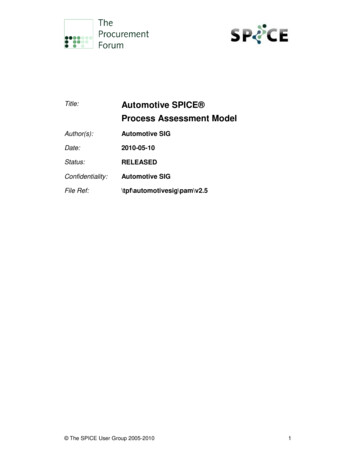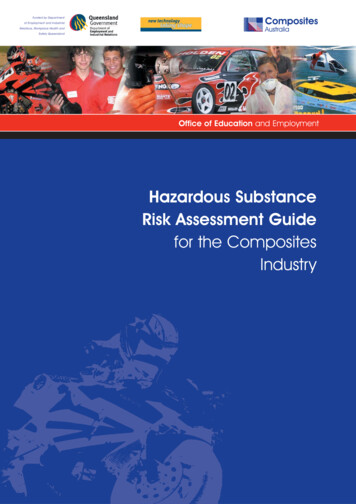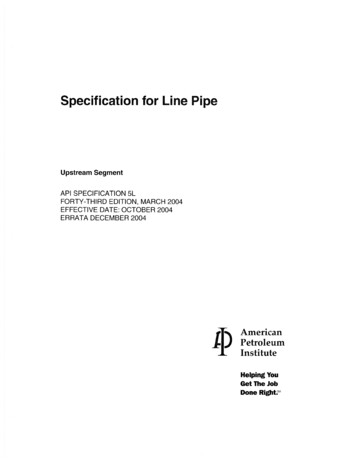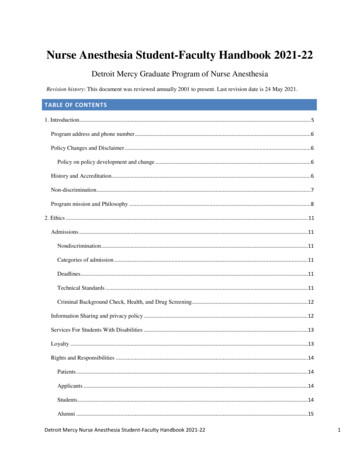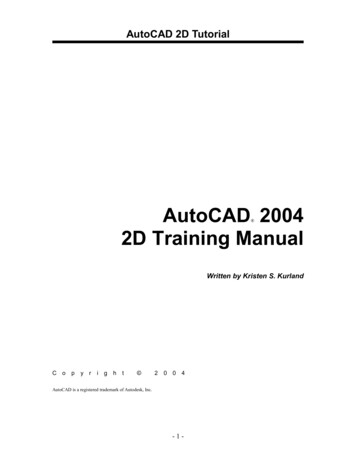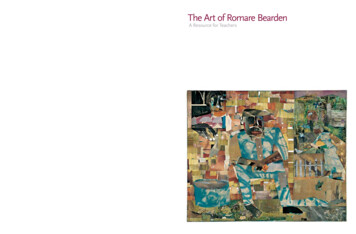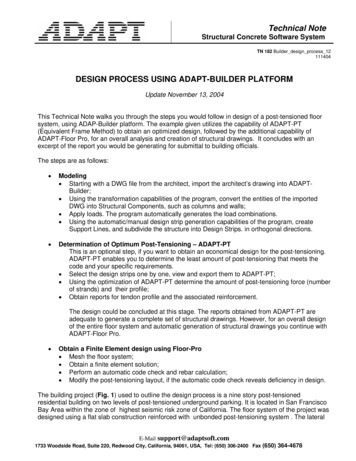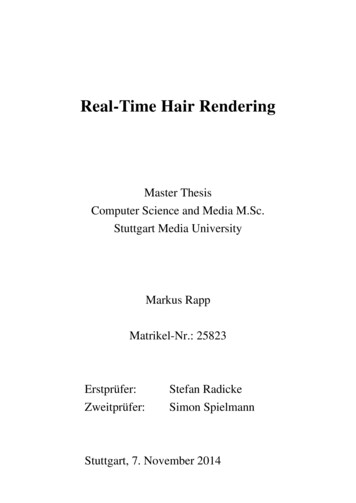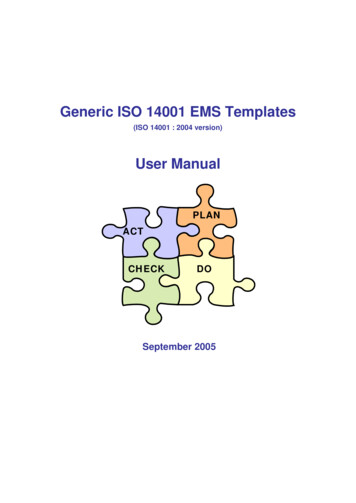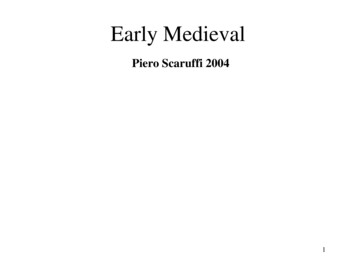
Transcription
Early MedievalPiero Scaruffi 20041
What the Middle Ages knew Political revolution (feudalism)Commercial revolution (communes)Agricultural revolution (manors)Educational revolution (monasteries, universities)Engineeting/artistic revolution (cathedrals)Technological revolution (machines)Military revolution (gunpowder)2
What the Middle Ages knew Christian conversion (300-1000)Arab invasion (711-1492)Monasticism (318-1347)Feudalism (980-1453)Cathedrals (900-1280)Chivalry (8th c)Holy Roman Empire (800)ManorsArchitectural boom (1000)3
What the Middle Ages knew Christian conversion of the Pagans– During the Roman empire Christianity was anurban phenomenon– In the early Middle Ages, rural churches andmonasteries spread it to the rural population(“pagus” countryside)4
What the Middle Ages knew Christian conversion of the Pagans– 340: Christianization and literalization of the Goths (Ulfilaand the "Gothic bible")– 360: the Vandals convert to christianity– 371: Martin of Tours converts pagans– 376: Visigoths convert to Arian christianity– 432: missionary Patrick is taken prisoner to Ireland– 450: the first British monasteries are established in Wales– 496: Clovis converts Franks to catholicism– 587: the Visigothic king Recared converts to catholicism– 588: the Visigoths abandon Aryanism and convert tocatholicism– 597: Pope Gregory I dispatches monks to England5
What the Middle Ages knew Christian conversion of the Pagans– 603: the Lombards convert to Christianity and move theircapital to Pavia– 650: Arianism disappears after the Lombards convert tocatholicism– 670: Whitby monk Caedmon translates the gothic Bible intoGermanic vernacular (ancient english)– 678: Wilfrid evangelizes in Frisia (Holland)– 690: English missionary Willibrord evangelizes in Hollandand Denmark– 722: the Anglosaxon Benedectine monk Boniface (Wynfrid)evangelizes in Saxony– 800: Pope Leo III crowns Charles emperor of the HolyRoman Empire6
What the Middle Ages knew Christian conversion of the Pagans–––––––––––862: Boris of Bulgary converts to christianity862: Ratislav of Moravia converts to christianity870: The Serbs convert to christianity912: the Normans become Christian965: Denmark converts to christianity966: the ruler of Poland converts to Christianity988: Vladimir of Kiev converts to Christianity995 : Olav I conquers Norway and proclaims it Christian1008 AD: Sweden converts to Christianity1385: Lithuania unites with Poland and converts to1396: the English translation of the Bible, begun by JohnWycliffe, is completed (the "Wycliffe" Bible)7
What the Middle Ages knew Cosmas Indicopleustes: "Christian Topography"(547)– Voyages in the Mediterranean Sea, the Red Sea,and Persian Gulf– Description of Ethiopia (Axum), Persia, Ceylon– Destination: India– The universe is a tabernacle8
What the Middle Ages knew The Christian world under seige– Vikings from the north– Saracens (Muslims) from the south– Magyars (Hungarians) from the east9
What the Middle Ages knew Arab invasion– Breakdown of the economic and political unityof the Mediterranean Sea– International trade shrinks Papyrus disappears from Gaul/France(replaced by parchment) Spices disappear from France Silk disappears from France Gold is replaced by silver (silver "denarii")in France (Charlemagne, 781) Professional merchants disappear10
What the Middle Ages knew Arab invasion– Jews keep alive commerce - only economiclink between Islam and Christianity (slaves,gold, spices)– Venezia/Venice only economic link betweenHoly and Eastern Roman Empires (slaves,gold, spices)– Netherlands only economic link withScandinavia11
What the Middle Ages knew Arab invasion– Jews become the main intermediaries– Arabs sell spices to the Europeans via Jewishmerchants– Europeans sell furs, slaves, timber, metals tothe Arabs via Jewish merchants12
What the Middle Ages knew Breakdown of the unity of the Roman world– Arabs (southern empire)– Germans (northern empire)– Slavs (severe ties between Latin and Greekworld)– Three large ethnic groups install themselvesamong the traditional peoples of theMediterranean (Egyptians, Phoenicians, Jews,Greeks, Latins)13
What the Middle Ages knew Closing of the Medieval mind– Illiteracy widespread even among rulers– Christians, obsessed with heretics and battlingpagans, close libraries and burn books– The only roads are still the old Roman roads– Very little traffic of people or goods because theroads and seas are not secure– People live and die where they are born (dialectsdevelop)14
What the Middle Ages knew Closing of the Medieval mind– Pirates, bandits, warfare– And the closure of Arab-conquered ports– cause (8th c):– Decline of trade– which causes:– Decline of urban life (except Venezia/Venice) People abandon commerce and return to thefields An agricultural world under constant threatdoes not need a town: it needs a castle/fort15
What the Middle Ages knew Commercial revolution– Urban life replaced (8th c) by Episcopal cities Bourgs around castles– Big cities are vulnerable, small towns areeasier to defend Arles’ amphitheater Split’s Diocletian palace16
What the Middle Ages knew Commercial revolution– Trade fairs of 7th-9th c Decline of permanent trade fosters periodictrade The decline of sea trade fosters land trade Champagne, Flanders, northern Germany Largest: the yearly Fair of the Lendit at SaintDenis, near Paris (7th c) Peaked in 13th c17
What the Middle Ages knew Commercial revolution– Jewish merchants (Spain, France, Italy, England,Germany, etc)– Italian communes (10th c) Spices make the fortune of Venezia Venetian ban of Jews from their ships(competitors?)– Birth of a real bourgeois class– Capitalism is born in the competing city-states ofanarchic Italy, not in the cooperating environmentof stable Constantinople/Byzantium18
World Trade in the 8th century19
What the Middle Ages knew Commercial revolution– Year 1000: the Hungarian king converts toChristianity and the overland route toConstantinople/Byzantium reopens20
What the Middle Ages knew Capitals of Christianity– Constantinople/Byzantium (wealthiest cityuntil 1000)– Anthioch– Alexandria– (Jerusalem)– (Rome)21
What the Middle Ages knew Byzantium– Justin I (518-527) first Justinian– Justinian I (527-565) Restores empire’s grandeur (Italy, Balkans,southern Spain, North Africa, Asia Minor,Syria, Palestine) Revival of international trade Cosmas Indicopleustes of Alexandria sailsto Ethiopia and India Hagia Sophia, Byzantium (537) San Vitale, Ravenna (547) No longer Constantinople influenced byItalian culture but viceversa22
What the Middle Ages knew Byzantium– Wealthiest Christian city until 1000– Official language: Greek– Views the Western Europeans as barbarians– Gold currency that remains the standard foralmost 1000 centuries– Enemies: Persians (till 7th c), Arabs (from 7th c),Bulgars (from 7th c), Holy Roman Empire (afterFrederick Barbarossa 1190), Venezia, Serbia (12thc)– Allies: Khazars (Justinian II and Constantine Vmarry Khazar princesses)– Second city: Thessaloniki/Salonika23
What the Middle Ages knew Byzantium– Automata ofPelican History of Art24
What the Middle Ages knew Byzantium– Automata of25Pelican History of Art
What the Middle Ages knew Byzantium– Heraclean dynasty (610-717) Arabs conquer Syria, Palestine, Egypt– Isaurian dynasty (717-802) Iconoclastic Age (726-843): only abstractreligious art Rise of the Carolingian empire as acompetitor in northern Italy26
What the Middle Ages knew Byzantium– Macedonian dynasty (867-1056) Russia converts to Christianity (988) The Bulgar empire is annexed (1018) The Seljuq defeats the Byzantines at the battleof Mikert (1071) The Great Schism (1054) between Roman(“Catholic”) church and Byzantine (“Orthodox”)church27
What the Middle Ages knew Byzantium– Commene dynasty (1081-1185) Rise of Venezia as a competing power in theEastern Mediterranean Rise of the Normans as a competing power insouthern Italy Rise of the German emperor as a competingpower in northern Italy Weakening of the Byzantine Empire by theCrusades (hostility by the crusaders)28
What the Middle Ages knew Byzantium– 1204: Sack of Constantinople by the crusaders(led by Venezia/Venice) Latin dynasty on the Byzantine “empire” Greek kingdoms in Greece (Nicaea) Venezia becomes an empire by taking “onequarter and one half of one quarter” of theByzantine empire– 1261: Nicaea reunites the Byzantine “empire” Gradual advance of the Turks from the east Gradual advence of the Serbs from the north 1453: The Ottomans take Constantinople29
What the Middle Ages knew Monasticism and religious movements529: Benedetto of Nursia founds themonastery of Monte Cassino and codifieswestern monasticism (absolute power of theabbot)530: the Benedictine monk Cassiodorusencourages monks to copy manuscripts ofthe classics30
What the Middle Ages knew Monasticism and education– Martianus Capella of Carthage: "De nuptiisphilologiæ et Mercurii" (420): allegory of theseven maids that symbolize Grammar, Rhetoric,Dialectic, Arithmetic, Geometry, Astronomy,Music31
What the Middle Ages knew Monasticism and education– Magnus Aurelius Cassiodrus (Theodoric's ksecretary): "De artibus et disciplinis liberalium artium" (6th c) Seven liberal arts ("liber" "book") :– Trivium (Grammar, Rhetoric, Dialectic)– Quadrivium (Arithmetic, Geometry, Astronomy,Music) No science, no history, no mathematics, no literature Curriculum for education for his monastery in Apulia– Irish scribes introduce punctuation in their books (9th c)32
What the Middle Ages knew Benedectine monastery:– The organization of Time– "Regula Magistri" (510): discipline built around a"horologium"– Monastic chores and liturgical chores organizedon hourly basis– Origin of scheduling and of. punctuality– Public signaling of the hour– Seven canonical hours to mark the religious dutiesof the monks– Bells (5th C)– Bede: "De Temporibus" (704)– Development of the mechanical clock (via Islam33via China)
What the Middle Ages knew Benedectine monastery:– Each monastery is a completely autonomouscommunity (all crafts are included, from metalworkto farming)– A miniature town in the age of urban decline (asafe alternative to towns ransacked by warfare)– The center of culture also moves from the town tothe monastery34
What the Middle Ages knew Monasticism:– After 800, monasteries become state institutions– An urban alternative: economic, political andcultural unit– Benedictine monasteries become corrupted (10thc)35
What the Middle Ages knew Monasticism and religious movements– Cluny (910) & Odilo (1000): Rebellion against Benedictine corruption Rebellion against feudal interference End of Ottonian (German) domination of thepapacy Purify the whole Church from worldliness Victory of Cluny: Pope Gregory VII (1073) First international network of monasteries Cluniac movement becomes corrupt (11th c)36
What the Middle Ages knew Monasticism and religious movements– Monasticism recreates the unity of Christianitythrough a Europe-wide network ofinterconnected monasteries– A network of small units can mobilizeresources on a large scale37
What the Middle Ages knew Monasticism and religious movements– Cluny’s religious revolution Independence of the Church from the princes The liturgy is the process by which themonastery acts as intermediary betweenhumans and God Monks don't need to work anymore to supportthemselves Economic power: monasteries become theventure capitalists of agricultural Europe38
What the Middle Ages knew Monasticism and religious movements– Abbot Hugh (1049-1109) Cluny becomes a monastic empire Populism devotion diplomacy: respected bythe people, the church and the princes Builds Cluny III39
What the Middle Ages knew Monasticism and religious movements– The papacy completes Cluny’s revolution in1050-1099– The Church becomes Europe’s superpower– Slow decline of the German (Holy Roman)empire40
What the Middle Ages knew Monasticism and religious movements– Saint Bruno - Carthusians (1084): Rebellion against Cluny’s worldliness Radical desert-style monasticism41
What the Middle Ages knew Monasticism and religious movements– Cistercians (1098) Remote locations Churches mostly dedicated to the Virgin Mary (after1134) Vegetarian diet No religious art (sculptures forbidden in 1124, stonetowers in 1157, stained windows in 1182) Bernard (1115): fanatical orthodoxy (unio mystica),isolated from secular society, crusades Decline of Cluny 1200: There are 694 Cistercian monasteries42
What the Middle Ages knew Monasticism and religious movements– Peter Waldo(rich merchant) - Waldensian (1177):poverty– Albigensians/ Catharists (12th c): god of good vsgod of evil43
What the Middle Ages knew Monasticism and religious movements– Friars Lay people not priests Social welfare more than praying Largely indifferent to theology and doctrine Living in the real world San Francesco/Francis d’Assisi (1206):poverty, humility, beauty of the world(pantheism), argument based on example (ruralview) Domingo/Dominic de Guzman (1215): povertybut also philosophy, argument based on logic(urban view), and preaching against heresy 44
What the Middle Ages knew Monasticism and religious movements– New Christian beliefs The Virgin Mary– Bernard de Clairvaux: Mary as the symbolfor divine love The Anti-Christ– Adso: the Anti-Christ explains why Christhas not come yet45
What the Middle Ages knew Monasticism and religious movements– Pilgrimages Campostela (from France to Santiago)– Organized by Cluny, that becomesalso the main financial beneficiary– Monasteries serve as inns– Each faithful has to do it at least once– More important than the pilgrimage toRoma Roma Jerusalem46
What the Middle Ages knew Monast
Christian conversion (300-1000) . Vegetarian diet No religious art (sculptures forbidden in 1124, stone towers in 1157, stained windows in 1182) Bernard (1115): fanatical orthodoxy (unio mystica), isolated from secular society, crusades Decline of Cluny 1200: There are 694 Cistercian monasteries . 43 What the Middle Ages knew Monasticism and religious movements .
